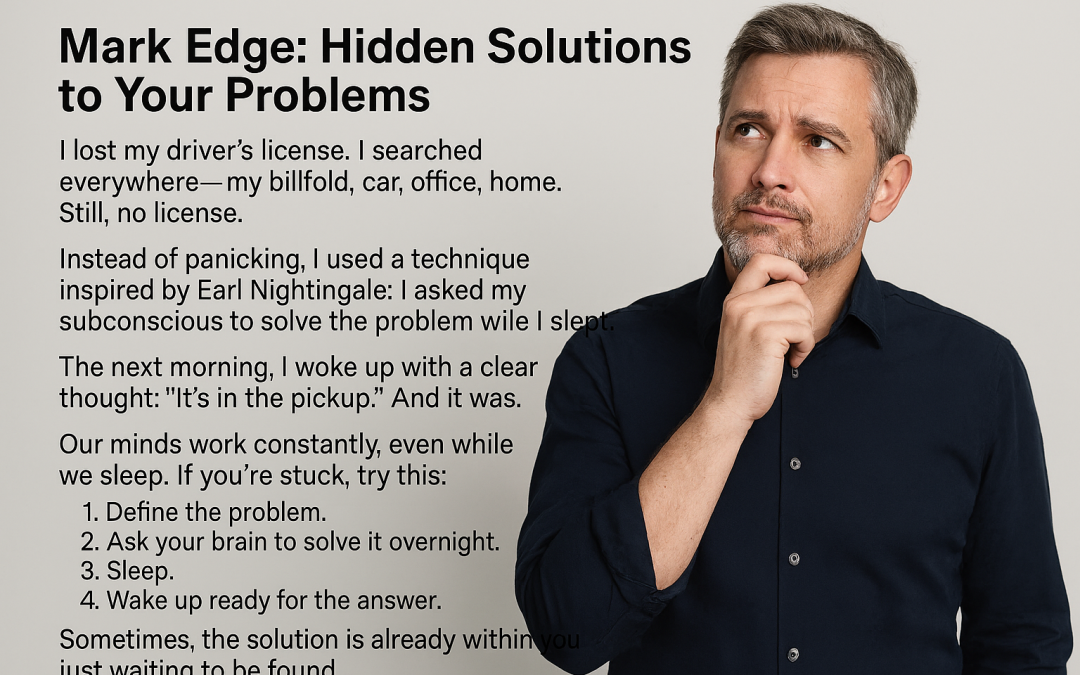Recently, I was required to show my driver’s license to gain entry into a venue. I looked inside my billfold, and my license was not there. I didn’t panic. I calmly and methodically scrolled through the contents of my billfold.
No license.
I stepped out into the parking lot and looked inside my car.
No license.
I drove to my office, looked inside and outside my desk.
No license.
Then the thought occurred to me: I must have left it at home. Later that day, when I arrived home, I looked for it.
No license.
And I’m telling you, I looked. I looked on the desk in my home office, checked my dresser, and searched the pockets of the clothes I had worn over the past few days.
No license.
Before going to bed that night, I spent some time pondering my situation. I knew I had a driver’s license somewhere. I simply had to find it. After considering my situation, I decided to let my subconscious mind take over. I told my brain, in effect, “I’m about to go to sleep. I am sure you have some idea where my driver’s license is. While I am asleep, I want you to look at your records, and when I awake in the morning, I want you to tell me where my license is.” I then put the problem out of my mind, did a little reading to relax, and went to sleep.
When I awoke, I felt a surge of confidence, accompanied by an overwhelming thought: “I think my driver’s license is in my pickup.” I went out to my pickup, and, lo and behold, I found my driver’s license in the front console. I had placed it there a few days before when I visited a bank drive-thru. Although I had expected to present it, the teller informed me it was not needed, so I set it down to avoid delaying the transaction. By the time I had finished, I had completely forgotten about my driver’s license. I had moved on.
But my subconscious mind had remembered. It was a relief to wake up that morning and find my driver’s license, solving my problem.
You likely know me enough to know this. I did not devise that method of problem-solving myself. I’m not that smart. I was actually inspired by a book my late father recommended to me years ago when I was a boy. It was written by Earl Nightingale, a great businessman and trainer. I developed my technique by hearing Mr. Nightingale describe the importance of setting and achieving a goal. He suggested that when pursuing a goal, one would inevitably encounter problems along the way. Rather than becoming exasperated with the issues, we should expect these challenges and allow them to sharpen our focus as we work towards achieving our goal.
Earl advised that if one faces a problem that seems insurmountable, he should not panic. Instead, he could focus on the challenge before going to bed and instruct his brain to find a solution. Then, he should sleep on it and hope to wake up with an answer. This method can be applied to a wide range of problems, from personal dilemmas to professional challenges.
You see, our brains work 24/7. They never rest. They manage countless processes, like ordering our hearts to beat and our lungs to breathe, without us even being aware of it. If an individual has spent a lot of time and effort investigating a problem, it is possible that she already has a solution in her own mind. She needs to prompt her brain to work on it while she sleeps and give her subconscious mind permission to give her a solution in the morning.
Is this method foolproof? Obviously not. But the next time you encounter a problem and find yourself at a solution impasse, try this:
- Summarize the problem in your mind.
- Instruct your brain to focus and give it permission to solve your problem.
- Delegate the task of revealing the answer to your subconscious mind for the morning.
- Then go to sleep.
Like me, you may awake with a solution on your lips.
Mark
Dr. Mark Edge
The WorkEdge Company
Telephone: 903-245-7851
Email: workedgetexas@gmail.com
Website: www.workedgetexas.com
Author of Holy Chaos To purchase the book, click here:

